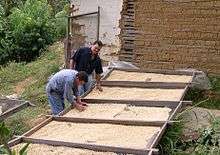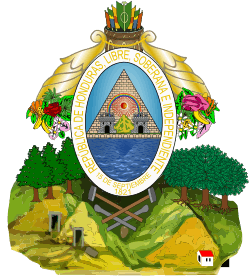Coffee production in Honduras

The coffee production in Honduras played a role in the country's history and is important for the Honduran economy. In 2011, the country became Central America's top producer of coffee.[1]
History
- 19th century
The cultivation of the coffee plant was in its infancy in the Republic of Honduras at the end of the 19th century. While there were numerous coffee plantations at the time, they were small. The soil, climate, and conditions in Honduras are the same as those of Guatemala, Nicaragua, or Costa Rica. The drawback in Honduras was lack of means of transportation and facilities for shipment to the coast. There was practically no exportation of coffee from Honduras, the product was mostly sold domestically. A new plantation of coffee would begin to produce a profit by the end of the fourth year after planting, and after the seventh year a profit of from 100 to 300 per cent on the capital invested could be expected.[2] The production of coffee in 1894 was reckoned at 20,000 quintals, of which only 10 per cent was exported. The exportation was from the Salvadoran ports Amapola and Puerto Cortes. In 1900, Honduras exported 54,510 pesos worth of coffee.[3]
References
 This article incorporates text from a work in the public domain: United States, Bureau of Foreign Commerce's "United States consular reports: Reports from the consuls of the United States on the commerce, manufactures, etc., of their consular districts" (1894)
This article incorporates text from a work in the public domain: United States, Bureau of Foreign Commerce's "United States consular reports: Reports from the consuls of the United States on the commerce, manufactures, etc., of their consular districts" (1894) This article incorporates text from a work in the public domain: Pan American Union's "Coffee: extensive information and statistics" (1902)
This article incorporates text from a work in the public domain: Pan American Union's "Coffee: extensive information and statistics" (1902)
- ↑ Guerrero, Jean (July 29, 2011). "A Prince of the Coffee Bean Honduras Becomes Central America's Top Producer, Helping to Fuel Its Economy". The Wall Street Journal. Retrieved 16 November 2011.
- ↑ United States, Bureau of Foreign Commerce (1894). United States consular reports: Reports from the consuls of the United States on the commerce, manufactures, etc., of their consular districts (Public domain ed.). G.P.O. pp. 402–. Retrieved 15 November 2011.
- ↑ Pan American Union (1902). Coffee: extensive information and statistics (Public domain ed.). Govt. Print. Off. pp. 21–. Retrieved 16 November 2011.

